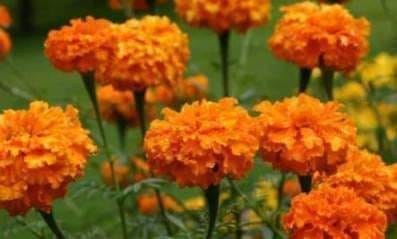
Marigolds are herbaceous plants, some perennial, some annual, of the Asteraceae family, the blooms made up of many tiny florets. They are native to North and South America but are popular garden plants throughout the world. Some of the more popular cultivated varieties are Mexican Marigold Tagetes erecta and French Marigold Tagetes patula.
History and Folklore
The Latin name Tagetes comes from the name Tages, an Etruscan prophet of ancient fame who taught others about divination. The common name, marigold, is from Mary’s Gold, though it was originally applied to calendula.
The marigold is an important flower in certain religious ceremonies in Nepal and is used to decorate Hindu temples in India. Marigold is considered the flower of the dead in Mexico where it is used to decorate ancestral altars for Day of the Dead celebrations. After the Spanish invasion, the Aztecs viewed the marigold flower as a symbol of the Spanish invasion and the massacre of their people and destruction of their way of life.
In the language of flowers, marigold means “pain and grief” or signifies a wish to comfort one who is grieving.
Growing Marigold
Marigold is easy to grow as an annual. There are some perennial varieties that grow well in tropical areas that can also be grown as as an annual in more temperate regions. Marigold can be grown from seed or young plants can be readily purchased at just about any nursery or the gardening section of your favorite big box store. It’s not picky about soil though they prefer it to be well-drained. Marigolds need a good sunny spot to thrive. Plant your marigolds in the spring as soon as the soil is warm and the danger of frost is past. If you keep your marigolds happy, they will bloom from spring right through to fall.
The scent of marigold is said to repel some insects and animals and chemicals released by their roots are said to repel nematodes. Because of this, it is considered an excellent companion plant for just about any other plant. However, it should not be used with legumes.
Marigold provides food for some species of butterflies and their larvae.
Healing with Marigold
The essential oil of Tagetes minuta or stinking Roger, usually sold as Tagetes oil can be used as an insect repellent and to prevent and help heal fungal and bacterial infections of the skin. It can be added to bath water or a vaporizer to help sooth coughs or added to a wash to help speed the healing of wounds, especially those that are weeping and slow to heal. A tea can be used for intestinal worms.
Tagetes oil is also used for aromatherapy to relieve tension and promote clear thinking and emotional control.
Tagetes lucida is used to in a tea to treat abdominal cramps, and in a bath to treat rheumatism, but it is also rumored to be strongly psychoactive and should be used with care.
Culinary Uses of Marigold
Tegates minuta is used as a culinary herb in South America where it is called huacatay. Tegates lucida is known as pericón or Texas tarragon is also used as a culinary herb and is used to make an anise-flavored tea in Mexico.
The petals of Tegates erecta flowers can be used in salads and to create a bright yellow dye.
Magical and Spiritual Use of Marigold
Mexican marigold resonates with the energy of the sun
Tagetes lucida has a psychoactive action and has been smoked ceremonially in combination with Nicotiana rustica when peyote was eaten and it may be drunk as a tea to promote visions.
All types of marigolds can be used as offerings to the dead and as decoration for ancestor altars.
Marigold Lore and Magic
Marigold must be taken only when the moon is in the Sign of the Virgin… And the gatherer, who must be out of deadly sin, must say three Pater Nosters and three Aves. It will give the wearer a vision of anyone who has robbed him.
Marigolds are a sturdy annual and quite familiar. They have been domesticated into a variety of sizes, some with tiny flowers, and others large and magnificent. Most have a golden color, but may range from bright yellow to deep, dark hues. The flowers may be gathered when in full bloom and hung upside down in a warm and dry place until the petals are completely dry.
They were said to relieve hiccups and the effects of being struck by lightning. No wonder they were considered magical plants. The marigold has healing properties and is used as a natural antifungal, antiseptic, and antibacterial treatment. Add the fresh flowers to salad greens and eat to promote good health and strengthen the immune system.
Make a tea by steeping the flowers and drink to solve love problems. Pour a quart of the tea into your bathwater on a Sunday to increase your popularity and admiration among peers. The seeds are sacred to Apollo and, when eaten, bring visions.
The marigold flower is rife with a variety of symbolism. To start, these flowers are called “the flower of the sun” and are representative of passion, warmth and creativity. To others, this flower is a symbol of comfort and contentment with simplicity. As a gift, marigolds may be a great expression of either warm or fiercely passionate love, or a simple way of saying that you feel happy and comfortable with the recipient. These flowers are sometimes given in themed gift baskets, but they are most commonly used in vibrant bouquets.
There are a number of different flowers commonly known as the Marigold, and when it comes to lore and magic, it can be confusing.
Common marigold (Tagetes) – Originally from South America, has been used as a source of essential oil for the perfume, and as a flavourant and food coloring in the food and tobacco industries. Tagetes is not to be confused with the genus Calendula, which goes by “marigold” in some areas.
Pot marigold (Calendula) – Flowers were used in ancient Greek, Roman, Middle Eastern and Indian cultures as a medicinal herb as well as a dye for fabrics, foods and cosmetics.
Mexican marigold (Tagetes erecta) – Dried leaves are ground into a powder then used as a tarragon substitute for flavoring soups, sauces etc. A pleasant anise-flavored tea, popular in Latin America, is brewed using the dried leaves and flowering tops. The petals are used as a condiment.
Tree marigold (Tithonia diversifolia) – Having a characteristic bitter taste, they were used to induce a fever to help fight poisoning, although not used for direct medicinal purposes.
Desert marigold (Baileya multiradiata) -A genus of three species in the aster family. Baileya species are used as food plants by the larvae of some Lepidoptera species (butterflies).
Corn marigold (Glebionis segetum) – In Crete and Greece, the leaves and the tender shoots of a variety called neromantilida (νερομαντηλίδα) are eaten raw in salads or browned in hot olive oil by the locals.
French marigold (Tagetes patula) -Medicinally, many cultures use infusions from dried leaves or florets.The whole plant is harvested when in flower and distilled for its essential oil
Marsh marigold (Caltha palustris) – As is the case with many members of the family Ranunculaceae, all parts of the plant are poisonous and can be irritant. Skin rashes and dermatitis have been reported from excessive handling of the plant.
Much of the traditional herbal lore and older magical information about the Marigold, is actually referring to the Pot Marigold or Calendula. What follows is what I have found that I am sure relates to the Common Marigold (tagates).
Marigolds are used as Visionary Herbes, and are part of the lore of Mexico. In that country it is sometimes said that they have their origin in the blood of the native peoples slain by the invading Spaniards. Marigolds are found in recipes for love divination, and it is also said that they give off bright sparks of light during a thunderstorm.
The species Tagetes lucida, known as “pericón,” is used to prepare a sweetish, anise flavored medicinal tea in Mexico, brewed using the dried leaves and flowering tops. It is also used as a culinary herb in many warm climates. Dried leaves are ground into a powder then used as a tarragon substitute for flavoring soups, sauces etc. and offered in the nursery as “Texas tarragon” or “Mexican mint marigold.”
The petals are used as a condiment. A yellow dye can be obtained from the flowers. The dried plant is burnt as an incense and to repel insects.
The marigold was regarded as the flower of the dead in pre-Hispanic Mexico, parallel to the lily in Europe, and is still widely used in the Day of the Dead celebrations to decorate ofrendas, papier mache and ceramic statues, altars, and graves of family members. This is because their scent is thought to draw back the souls of the dead.
Tagetes lucida was used by the Aztecs in their ritual incense known as Yauhtli. Aztecs used Tagete lucida both as a medicine and in rituals where they blew a powder made from the flowers on the faces of victims before the sacrifice.The plants was linked to the rain’s god Tlaloc. The plant is also used by the Huichol, mixed with a potent wild tobacco (Nicotiana rustica), for its claimed psychotropic and entheogenic effects.
Tagetes minuta, native to southern South America is a tall upright marigold plant with small flowers, and is used as a culinary herb in Peru, Ecuador, and parts of Chile and Bolivia, where it is called by the Incan term huacatay. Huacatay paste is used to make the popular potato dish called ocopa. Having both “green” and “yellow/orange” notes, the taste and odor of fresh Tagetes minuta is like a mixture of sweet basil, tarragon, mint and citrus. It is also used as a medicinal tea in some areas.
The marigold is very significant in Nepalese culture where marigold garlands are used almost in every household especially during the Tihar festival. It is always sold in the markets for daily worships and rituals.
The marigold is also widely cultivated in India and Thailand, particularly the species Tagates erecta, Tagates patula, and Tagates tenuifolia. Vast quantities of marigolds are used in garlands and decoration for weddings, festivals, and religious events.
In Ukraine, Tagetes erecta, Tagetes patula, and the signet marigold, Tagetes tenuifolia are regarded as one of the national symbols, and are often mentioned in songs, poems and tales.








